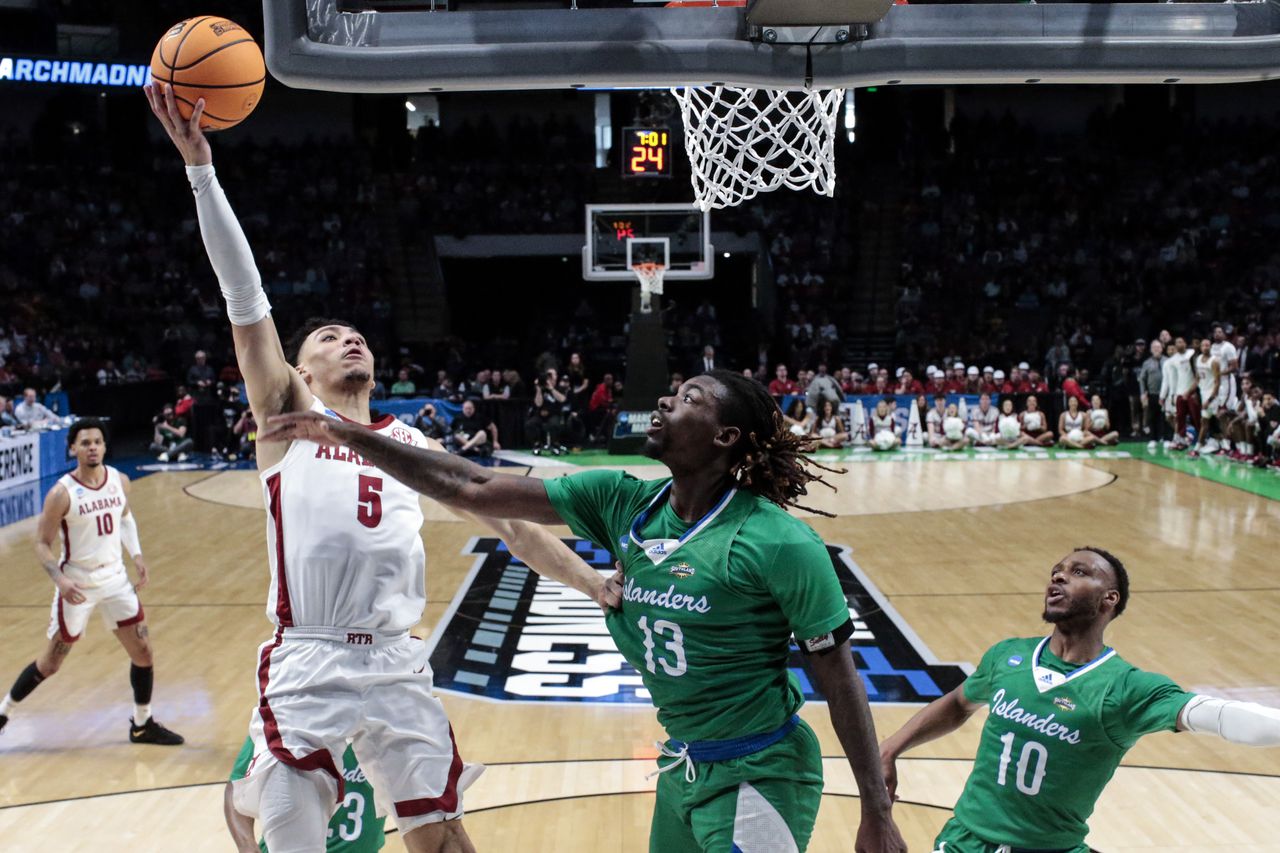Alabama’s Jahvon Quinerly is healthy and thriving in March Madness. Again.
Jahvon Quinerly still didn’t feel right.
His whole career, from Hudson (NJ) Catholic to Villanova then Alabama, Quinerly had played with instinct. But he was timid during practice in Tuscaloosa last fall. He questioned the strength of his left knee, which was even more frustrating considering Quinerly had undergone tests on a force plate and knew he was back to his pre-injury numbers. The rust of a six-month, seven-a-days-a-week rehab was showing and that sent Quinerly to, as he put it, “panic mode.”
“Look, I can’t do this how I used to do it,” he recalled telling Alabama trainer Clarke Holter.
“Look, you gotta be patient. It’s all going to come back at the right time,” Holter responded.
Quinerly has lived a unique college basketball life for the last five-and-a-half years: a ‘Jellyfam’ star rising in the nascent player-empowerment era; a prospect caught up in the Arizona-FBI probe; a player who suffered an ACL tear in the NCAA Tournament. In hindsight, it’s obvious that Quinerly would regain form in March, the sport’s esteemed month.
Since transferring to the Tide in 2020 and leading the team to an SEC championship and two wins in the Big Dance, Quinerly has earned the nickname ‘March JQ.’ Like Reggie Jackson’s Mr. October, Quinerly elevates his game when it matters most. In 16 March games, not including the three minutes before his injury against Notre Dame last season, Quinerly is averaging more points per game (14.8) and is shooting 3-pointers at a better rate (36.1%) than his career averages.
Quinerly has a special appreciation for this re-debut. There were times this year he didn’t think he’d ever play like his normal self while rehabbing his knee. As coach Nate Oats said this week, Quinerly pushed himself, making his first appearance on Nov. 15 at South Alabama, which meant Quinerly had to regain his skillset and confidence while fighting for minutes. There wasn’t a specific moment when he felt “back,” Quinerly said. Yet, his teammates have a good idea when they noticed.
Alabama guard Jahvon Quinerly (5) shoots over Texas A&M-CC forward De’Lazarus Keys (13) during the first half of a first-round college basketball game in the men’s NCAA Tournament in Birmingham, Ala., Thursday, March 16, 2023. Alabama won 96-75. (AP Photo/Butch Dill)AP
RELATED: Brandon Miller dealing with groin injury during first week of NCAA tournament
Goodman: True madness is here for Auburn and Alabama
What Alabama said about No. 8 Maryland ahead of NCAA Tournament 2nd round
“The day before he got hurt and tore his ACL last year, he was as locked in as I’ve ever seen him,” sophomore Nimari Burnett said. ” … This is his time. He works super hard for these moments and I know he dreamed of these moments when he was a kid. He’s one of the most talented players in the country in my opinion. This is his time to display that.”
The initial recovery timeframe was eight months, according to Quinerly’s surgeon Dr. Lyle Cain, a member of Andrews Sports Medicine and Orthopedic in Birmingham. Quinerly said it took him five months to start cutting again, let alone dribble a basketball. Cain, who was in constant contact with Alabama’s medical staff, called Quinerly’s rehab a full-time job or “practice-plus.” Seven days a week, twice with a specialist, Quinerly would loosen his joints and start mobilizing his leg.
The goal was to have Quinerly back for conference games, but Quinerly had to learn to trust his athleticism again. Quinerly talked to Burnett, former teammate James Rojas and Seton Hall’s Sterling Gibbs, all of whom tore their ACLs and had already returned. Their messages overlapped with Holter’s: Be patient.
“I know it sounds simple, but on the court just go,” Quinerly said. “Go as fast as you can, go as hard as you can and you forget about it. … If you’re sitting there like, ‘Maybe I shouldn’t go fast this time’ cause that’s when you’re overthinking it. Kind of at the beginning of the year, it would linger. It would go away, and come back, it’s something that’s really hard to control on your own. I think I’ve got it figured out now.”
His brother, walk-on Jaden Quinerly and Burnett said they could tell when Quinerly is in a rhythm by his defense. An effort dive onto the floor, a poke-away steal and layup, then the “switch turns.” Burnett has noticed Quinerly’s pupils dilate, his first step gets a little quicker when ‘March JQ’ takes over.
In the second half of Alabama’s SEC tournament finals against Texas A&M last week, Quinerly reset a play and recognized a mismatch. He bounced the ball behind his back as a fan yelled “Go get ‘em, JQ” and Quinerly delivered a finger roll. As Cain noted after watching Quinerly in Birmingham’s Legacy Arena this week, his aggression on the court matched the vigor of his rehab.
Throughout this run, potentially his last with the Tide, Quinerly believes he’s had to prove himself again. There aren’t many carry-over players from the Sweet 16 run he helped lead two seasons ago when Alabama beat Maryland. He’s relied on the motivation given to him by those that have seen him thrive in the past, like his brother or walk-on Adam Cottrell.
“I’ve kinda just had a full mindset change in terms of not worrying about my injury. That’s allowed me to be 100% locked in,” Quinerly said. ” … Everything I’ve been through gives me that edge out there.”
On Saturday, once again facing the Terrapins, Quinerly will get another chance to shine in March.
Nick Alvarez is a reporter for Alabama Media Group. Follow him on Twitter @nick_a_alvarez or email him at [email protected].
